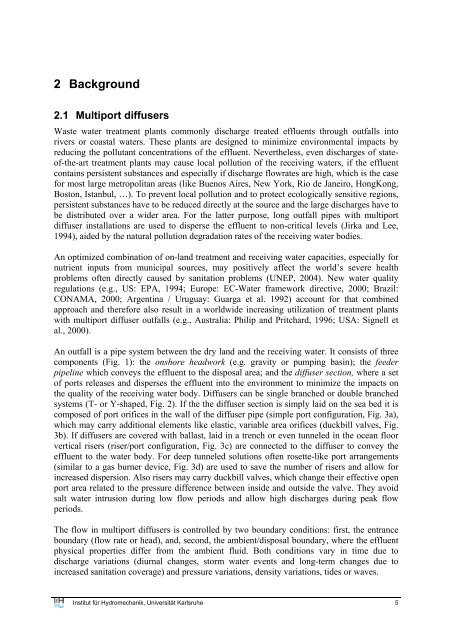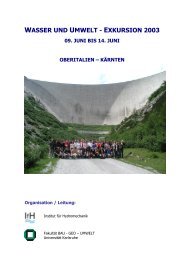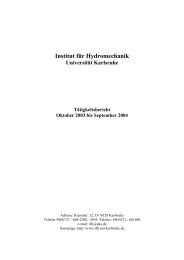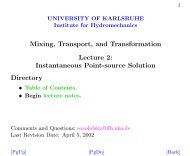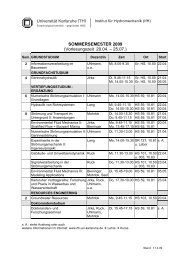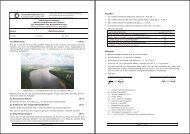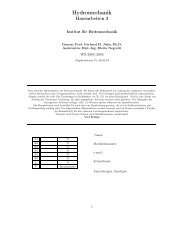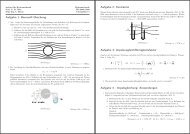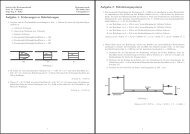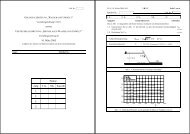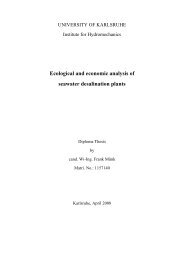user's manual for corhyd: an internal diffuser hydraulics model - IfH
user's manual for corhyd: an internal diffuser hydraulics model - IfH
user's manual for corhyd: an internal diffuser hydraulics model - IfH
You also want an ePaper? Increase the reach of your titles
YUMPU automatically turns print PDFs into web optimized ePapers that Google loves.
2 Background<br />
2.1 Multiport <strong>diffuser</strong>s<br />
Waste water treatment pl<strong>an</strong>ts commonly discharge treated effluents through outfalls into<br />
rivers or coastal waters. These pl<strong>an</strong>ts are designed to minimize environmental impacts by<br />
reducing the pollut<strong>an</strong>t concentrations of the effluent. Nevertheless, even discharges of stateof-the-art<br />
treatment pl<strong>an</strong>ts may cause local pollution of the receiving waters, if the effluent<br />
contains persistent subst<strong>an</strong>ces <strong>an</strong>d especially if discharge flowrates are high, which is the case<br />
<strong>for</strong> most large metropolit<strong>an</strong> areas (like Buenos Aires, New York, Rio de J<strong>an</strong>eiro, HongKong,<br />
Boston, Ist<strong>an</strong>bul, …). To prevent local pollution <strong>an</strong>d to protect ecologically sensitive regions,<br />
persistent subst<strong>an</strong>ces have to be reduced directly at the source <strong>an</strong>d the large discharges have to<br />
be distributed over a wider area. For the latter purpose, long outfall pipes with multiport<br />
<strong>diffuser</strong> installations are used to disperse the effluent to non-critical levels (Jirka <strong>an</strong>d Lee,<br />
1994), aided by the natural pollution degradation rates of the receiving water bodies.<br />
An optimized combination of on-l<strong>an</strong>d treatment <strong>an</strong>d receiving water capacities, especially <strong>for</strong><br />
nutrient inputs from municipal sources, may positively affect the world’s severe health<br />
problems often directly caused by s<strong>an</strong>itation problems (UNEP, 2004). New water quality<br />
regulations (e.g., US: EPA, 1994; Europe: EC-Water framework directive, 2000; Brazil:<br />
CONAMA, 2000; Argentina / Uruguay: Guarga et al. 1992) account <strong>for</strong> that combined<br />
approach <strong>an</strong>d there<strong>for</strong>e also result in a worldwide increasing utilization of treatment pl<strong>an</strong>ts<br />
with multiport <strong>diffuser</strong> outfalls (e.g., Australia: Philip <strong>an</strong>d Pritchard, 1996; USA: Signell et<br />
al., 2000).<br />
An outfall is a pipe system between the dry l<strong>an</strong>d <strong>an</strong>d the receiving water. It consists of three<br />
components (Fig. 1): the onshore headwork (e.g. gravity or pumping basin); the feeder<br />
pipeline which conveys the effluent to the disposal area; <strong>an</strong>d the <strong>diffuser</strong> section, where a set<br />
of ports releases <strong>an</strong>d disperses the effluent into the environment to minimize the impacts on<br />
the quality of the receiving water body. Diffusers c<strong>an</strong> be single br<strong>an</strong>ched or double br<strong>an</strong>ched<br />
systems (T- or Y-shaped, Fig. 2). If the the <strong>diffuser</strong> section is simply laid on the sea bed it is<br />
composed of port orifices in the wall of the <strong>diffuser</strong> pipe (simple port configuration, Fig. 3a),<br />
which may carry additional elements like elastic, variable area orifices (duckbill valves, Fig.<br />
3b). If <strong>diffuser</strong>s are covered with ballast, laid in a trench or even tunneled in the oce<strong>an</strong> floor<br />
vertical risers (riser/port configuration, Fig. 3c) are connected to the <strong>diffuser</strong> to convey the<br />
effluent to the water body. For deep tunneled solutions often rosette-like port arr<strong>an</strong>gements<br />
(similar to a gas burner device, Fig. 3d) are used to save the number of risers <strong>an</strong>d allow <strong>for</strong><br />
increased dispersion. Also risers may carry duckbill valves, which ch<strong>an</strong>ge their effective open<br />
port area related to the pressure difference between inside <strong>an</strong>d outside the valve. They avoid<br />
salt water intrusion during low flow periods <strong>an</strong>d allow high discharges during peak flow<br />
periods.<br />
The flow in multiport <strong>diffuser</strong>s is controlled by two boundary conditions: first, the entr<strong>an</strong>ce<br />
boundary (flow rate or head), <strong>an</strong>d, second, the ambient/disposal boundary, where the effluent<br />
physical properties differ from the ambient fluid. Both conditions vary in time due to<br />
discharge variations (diurnal ch<strong>an</strong>ges, storm water events <strong>an</strong>d long-term ch<strong>an</strong>ges due to<br />
increased s<strong>an</strong>itation coverage) <strong>an</strong>d pressure variations, density variations, tides or waves.<br />
Institut für Hydromech<strong>an</strong>ik, Universität Karlsruhe 5


